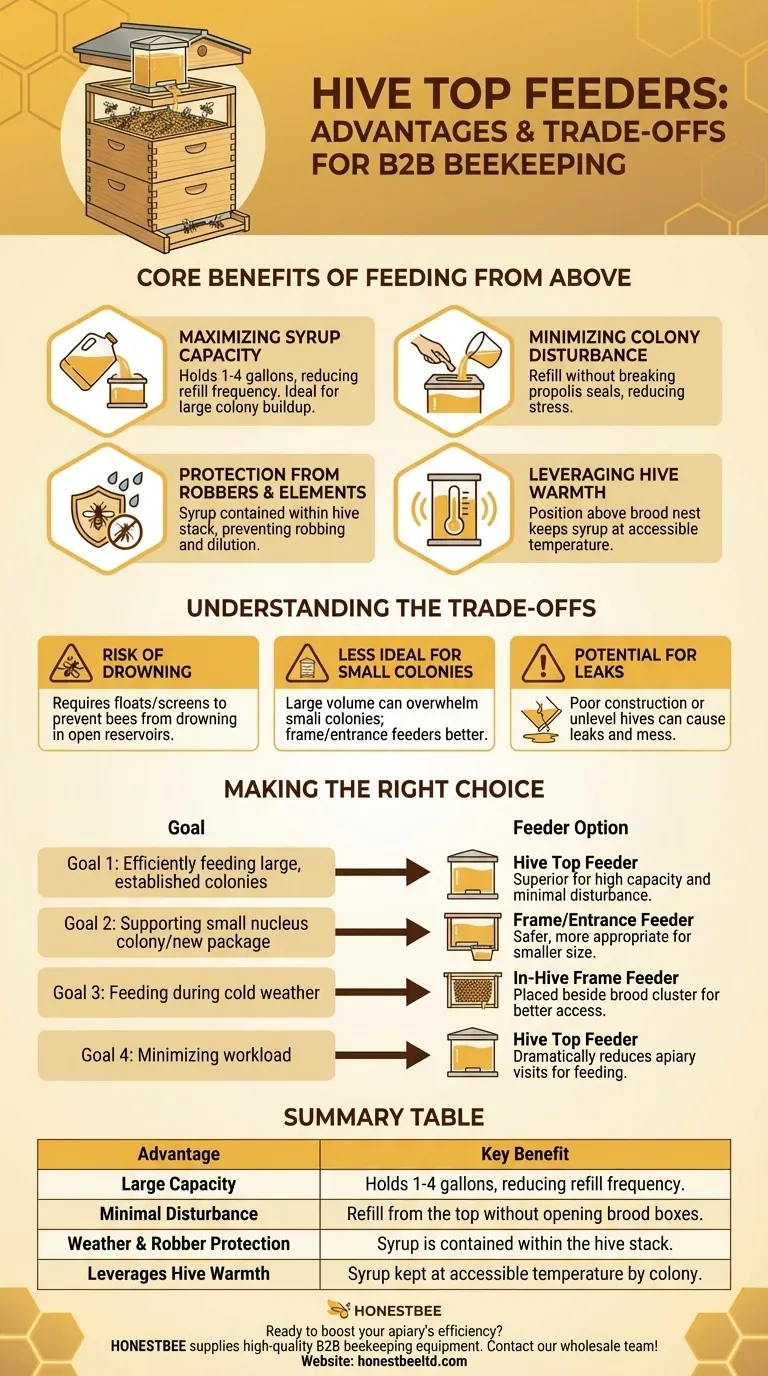In short, hive top feeders are favored for their massive syrup capacity and the minimal disturbance required to refill them. They are placed above the uppermost hive box, allowing a beekeeper to add gallons of syrup at a time without fully opening the hive and disrupting the colony's work. This makes them exceptionally efficient for feeding large colonies or providing sustained support during a nectar shortage.
The primary advantage of a hive top feeder is not just its size, but its strategic placement. By sitting on top of the hive, it allows for efficient, large-volume feeding that minimizes stress on both the bees and the beekeeper.

The Core Benefits of Feeding from Above
Hive top feeders solve several key challenges for the beekeeper, primarily revolving around scale, efficiency, and colony health.
Maximizing Syrup Capacity
A standard hive top feeder can hold one to four gallons of syrup. This high volume is a significant advantage, as it reduces the frequency of refills.
For a large, populous colony, a consistent and abundant food source is critical for buildup, especially when natural nectar is scarce. Fewer refills mean a more stable supply for the bees.
Minimizing Colony Disturbance
Refilling a hive top feeder is a minimally invasive process. The beekeeper simply removes the telescoping outer cover and the top of the feeder to pour in more syrup.
There is no need to break the propolis seals on the brood boxes or smoke the bees heavily. This drastically reduces stress on the colony, allowing them to maintain their internal temperature and organization.
Protection from Robbers and the Elements
Because the feeder is contained within the hive stack (usually surrounded by an empty deep box), the syrup is protected.
This design prevents bees from other colonies ("robber bees") and other insects like wasps from accessing the food source, which can prevent hive robbing. It also keeps rain from diluting the syrup.
Leveraging Hive Warmth
The feeder's position directly above the brood nest allows it to be warmed by the colony's radiant heat.
This keeps the syrup at a more accessible temperature, encouraging the bees to travel upward to feed, even on cooler days when they might not venture outside.
Understanding the Trade-offs
While effective, hive top feeders are not a perfect solution for every scenario. Objectivity requires acknowledging their potential downsides.
Risk of Drowning
Some hive top feeder designs have open reservoirs of syrup. Without proper floats, screens, or textured ladders, bees can easily fall in and drown.
It is critical to select a modern design with built-in protections or to add your own materials (like wooden floats or plastic mesh) to give bees a safe way to access the syrup.
Less Ideal for Small Colonies
The large surface area and volume of a hive top feeder can be overwhelming for a small nucleus colony or a new package.
A smaller colony may have trouble accessing the food, defending the large space, or consuming the syrup before it spoils. In these cases, a smaller frame feeder or entrance feeder is often a better choice.
Potential for Leaks
A poorly constructed feeder or an unlevel hive can cause syrup to leak down into the main hive body.
This can drown bees, attract pests, and create a sticky mess that agitates the colony. Careful setup and periodic checks are necessary to ensure the feeder is seated properly and is not cracked.
Making the Right Choice for Your Goal
Selecting a feeder depends entirely on the specific needs of your colony and your management style.
- If your primary focus is efficiently feeding large, established colonies: The high capacity and minimal disturbance of a hive top feeder make it the superior choice.
- If your primary focus is supporting a small nucleus colony or new package: A smaller in-hive frame feeder or an entrance feeder is safer and more appropriate for their size.
- If your primary focus is feeding during cold weather: An in-hive frame feeder placed directly beside the brood cluster may ensure better access than a top feeder.
- If your primary focus is minimizing your workload: A hive top feeder dramatically reduces the number of trips you need to make to your apiary for feeding.
Ultimately, choosing the right equipment is about understanding your bees and providing support in the most effective, least disruptive way possible.
Summary Table:
| Advantage | Key Benefit |
|---|---|
| Large Capacity | Holds 1-4 gallons of syrup, reducing refill frequency. |
| Minimal Disturbance | Refill from the top without opening the brood boxes. |
| Weather & Robber Protection | Syrup is contained within the hive stack. |
| Leverages Hive Warmth | Syrup is kept at an accessible temperature by the colony. |
Ready to boost your apiary's efficiency? Hive top feeders are essential for commercial beekeepers and distributors managing large colonies. At HONESTBEE, we supply high-quality, durable beekeeping equipment designed for wholesale operations. Let us help you streamline your feeding process and support stronger, more productive hives.
Contact our wholesale team today to discuss your equipment needs and volume pricing!
Visual Guide

Related Products
- Professional Hive Top Bee Feeder for Beekeeping
- HONESTBEE Professional Hive Top Bee Feeder Feeding Solution
- HONESTBEE Round Hive Top Bee Feeder for Syrup
- Boardman Entrance Bee Feeder Durable Galvanized Steel and Wood Construction for Beekeeping
- HONESTBEE Entrance Bee Feeder Professional Hive Nutrition Solution for Beekeeping
People Also Ask
- Do I need an inner cover with a hive top feeder? Optimize Your Hive Setup for Healthy Bees
- How to use a top feeder in a beehive? A Guide to Effective Beehive Feeding
- What is a top feeder for bees? Maximize Colony Health with Efficient Feeding
- What types of hive boxes is the round hive top feeder compatible with? Universal Fit for 8 & 10-Frame Langstroth Hives
- How is the plywood floor fitted into the hive-top feeder? Ensure Longevity with a Floating Floor Design



















